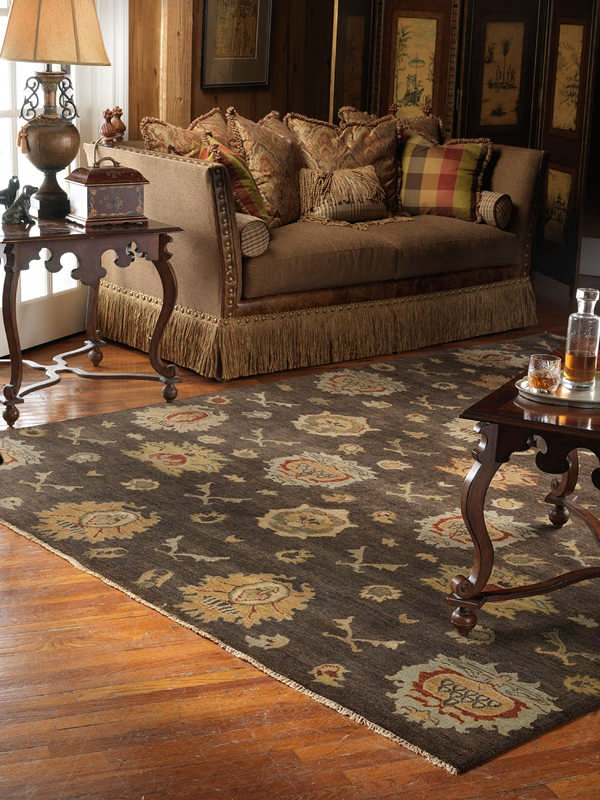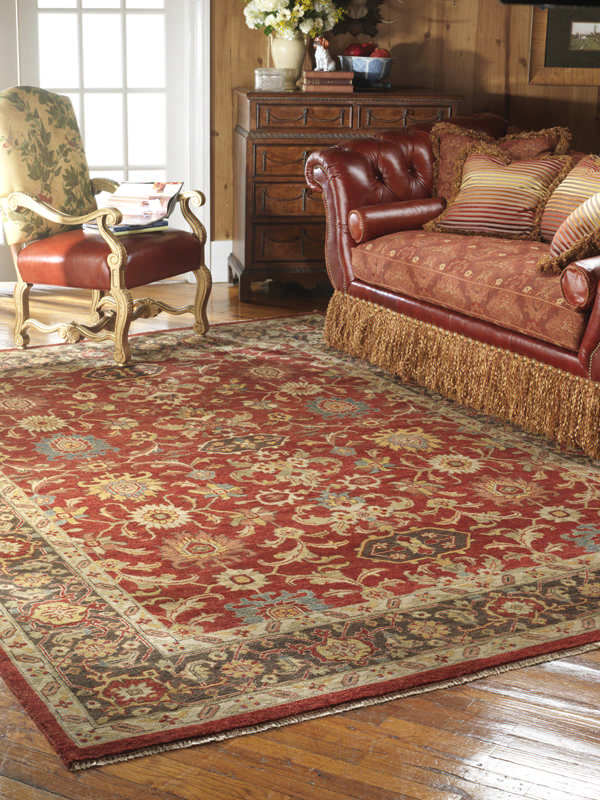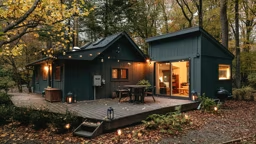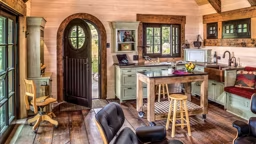While uninterrupted layouts have their benefits, you may need to do a lot of thinking about how to delineate each of the areas within open floor plans.
Photos courtesy of
Kalaty Rug Corporation

In today’s open-plan homes, comfort knows no boundaries. Airy open living spaces are more popular than ever, offering unobstructed interior views and traffic patterns that allow friends and family to move freely and comfortably between living, dining and kitchens spaces.
By their nature, log and timber homes have built-in structures (vertical frame posts and decorative timbers, etc.) that help with this challenge. These wood elements are necessary for the structural integrity of the house, but you also can utilize these structural devices to create hallways, frame the entryway, section off and separate rooms or establish preferred traffic patterns.
Other design features that you can incorporate include knee walls, sunken rooms and varied floor materials that help visually divide open spaces with your home’s interior.
You may also want to consider such decorative touches as area rugs to elevate your aesthetics as well as the practicality of interior space separation. Great area rugs emphasize each space, anchor them, tie furniture arrangements together and serve as visual boundaries delineating room function within spacious open-plan homes.
Here are a few factors to consider when choosing area rugs for your open plan:
Size
Keep the following in mind when choosing the area rug size that’s best for each room:
For bedrooms there are two options that work best for most situations:
- Choose an area rug that fits the size of your bed and extends a minimum of two feet on both sides of the bed.
- Consider using a runner on each side of the bed. Runners not only accent the sides of your beds but they also prevent the majority of a larger rug from being hidden beneath the bed.
F or dining room/dining areas
or dining room/dining areas your rug should fully encompass the table and include all chairs – even when they’re in a pulled-out position.
For family room or living room conversation groupings your area rug should anchor and define the entire space. Interior designers suggest that you allow at least 18 inches of wood floor to be exposed around the perimeter of a rug while supporting the two most acceptable scenarios for conversation area rug size:
At least the front legs of all seating furniture should fit on your rug.
The size of your rug should accommodate all of your seating furniture.
Shape
To determine rug shape, consider your overall room configuration. Various rug shapes are readily available from many sources:
Rectangles: The most common rug shape and used primarily for most living rooms, family rooms and dining areas, rectangular rugs usually range from 2x3’ to 12x15’ and larger.
 Squares:
Squares: Depending on the size and shape of your room, a square rug is a good option. A square rug can be especially appropriate for an entry or foyer. Standard sizes for square rugs are 6’, 8’ and 10’.
Rounds: If you’re looking to define an entry area or foyer, a round rug often works well depending on the shape of your space. For a round dining table, a round rug can be especially appropriate. Standard sizes for round rugs range from 4’, 6’, 8’ and 10’ in diameter.
Runners: Runners are elongated rectangular rugs available in various sizes. While runners have a number of uses, they are especially well suited to hallways and other long narrow areas. Designers often suggest using runners on both sizes of a bed.
Caution: Whatever shape rug you choose, be careful not to choose a rug that is too small for the space. For area rugs, the best rule is to go larger than smaller.
Color/Pattern
Although some people view rugs as accessories, area rugs can be the foundation of any space. Many designers advise that an area rug should be the "soul of your room" and that your color scheme, furniture placement and accessories should all connect back to it. A handsome area rug, therefore, can be the perfect beginning for a room’s color scheme and theme.
Color affects and inspires most of the choices we make in our lives, from the food we eat to the clothes we wear to the décor choices we make for our homes.
In rooms featuring mostly solid colors, a patterned rug in your favorite style (traditional, transitional or modern) will anchor, warm and tie together your furniture. In a bedroom, your rug should support the restful nature of the colors and patterns found in your bedding and window treatments.
Here’s a tip that applies to any carpeted rooms in your home: Don’t be afraid to use area rugs to divide areas within carpeted rooms. Like rooms with wood floors, carpeted spaces also benefit from the added color and pattern of a smartly chosen area rug to anchor furniture and tie spaces together.
Kalaty Rug Corporation is a family business that has been setting the gold standard for area rugs for generations. Highly respected for its superior quality handcrafted rugs, the company has built a reputation for its ability to combine color and design to create a broad range of area rugs that portray “Tradition for Today.”
 In today’s open-plan homes, comfort knows no boundaries. Airy open living spaces are more popular than ever, offering unobstructed interior views and traffic patterns that allow friends and family to move freely and comfortably between living, dining and kitchens spaces.
By their nature, log and timber homes have built-in structures (vertical frame posts and decorative timbers, etc.) that help with this challenge. These wood elements are necessary for the structural integrity of the house, but you also can utilize these structural devices to create hallways, frame the entryway, section off and separate rooms or establish preferred traffic patterns.
Other design features that you can incorporate include knee walls, sunken rooms and varied floor materials that help visually divide open spaces with your home’s interior.
You may also want to consider such decorative touches as area rugs to elevate your aesthetics as well as the practicality of interior space separation. Great area rugs emphasize each space, anchor them, tie furniture arrangements together and serve as visual boundaries delineating room function within spacious open-plan homes.
Here are a few factors to consider when choosing area rugs for your open plan:
In today’s open-plan homes, comfort knows no boundaries. Airy open living spaces are more popular than ever, offering unobstructed interior views and traffic patterns that allow friends and family to move freely and comfortably between living, dining and kitchens spaces.
By their nature, log and timber homes have built-in structures (vertical frame posts and decorative timbers, etc.) that help with this challenge. These wood elements are necessary for the structural integrity of the house, but you also can utilize these structural devices to create hallways, frame the entryway, section off and separate rooms or establish preferred traffic patterns.
Other design features that you can incorporate include knee walls, sunken rooms and varied floor materials that help visually divide open spaces with your home’s interior.
You may also want to consider such decorative touches as area rugs to elevate your aesthetics as well as the practicality of interior space separation. Great area rugs emphasize each space, anchor them, tie furniture arrangements together and serve as visual boundaries delineating room function within spacious open-plan homes.
Here are a few factors to consider when choosing area rugs for your open plan:
 or dining room/dining areas your rug should fully encompass the table and include all chairs – even when they’re in a pulled-out position.
For family room or living room conversation groupings your area rug should anchor and define the entire space. Interior designers suggest that you allow at least 18 inches of wood floor to be exposed around the perimeter of a rug while supporting the two most acceptable scenarios for conversation area rug size:
At least the front legs of all seating furniture should fit on your rug.
The size of your rug should accommodate all of your seating furniture.
or dining room/dining areas your rug should fully encompass the table and include all chairs – even when they’re in a pulled-out position.
For family room or living room conversation groupings your area rug should anchor and define the entire space. Interior designers suggest that you allow at least 18 inches of wood floor to be exposed around the perimeter of a rug while supporting the two most acceptable scenarios for conversation area rug size:
At least the front legs of all seating furniture should fit on your rug.
The size of your rug should accommodate all of your seating furniture.
 Squares: Depending on the size and shape of your room, a square rug is a good option. A square rug can be especially appropriate for an entry or foyer. Standard sizes for square rugs are 6’, 8’ and 10’.
Rounds: If you’re looking to define an entry area or foyer, a round rug often works well depending on the shape of your space. For a round dining table, a round rug can be especially appropriate. Standard sizes for round rugs range from 4’, 6’, 8’ and 10’ in diameter.
Runners: Runners are elongated rectangular rugs available in various sizes. While runners have a number of uses, they are especially well suited to hallways and other long narrow areas. Designers often suggest using runners on both sizes of a bed.
Caution: Whatever shape rug you choose, be careful not to choose a rug that is too small for the space. For area rugs, the best rule is to go larger than smaller.
Squares: Depending on the size and shape of your room, a square rug is a good option. A square rug can be especially appropriate for an entry or foyer. Standard sizes for square rugs are 6’, 8’ and 10’.
Rounds: If you’re looking to define an entry area or foyer, a round rug often works well depending on the shape of your space. For a round dining table, a round rug can be especially appropriate. Standard sizes for round rugs range from 4’, 6’, 8’ and 10’ in diameter.
Runners: Runners are elongated rectangular rugs available in various sizes. While runners have a number of uses, they are especially well suited to hallways and other long narrow areas. Designers often suggest using runners on both sizes of a bed.
Caution: Whatever shape rug you choose, be careful not to choose a rug that is too small for the space. For area rugs, the best rule is to go larger than smaller.










